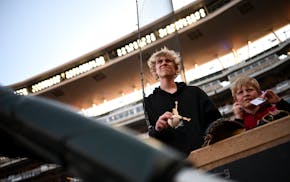Carter Coughlin got the idea from a history textbook.
The highly coveted Eden Prairie football recruit was reading about the Roman Empire last year, and thought about how the glossary word empire might relate to the Gophers.
"Empire was like a connection of groups of people from different areas and joining them together under one leader, with one common goal," Coughlin said. "And it was like, well, that's what Coach [Jerry] Kill's doing."
After committing to the Gophers last March, Coughlin began referring to this as "The Empire Class." He had maroon T-shirts made with that theme for Minnesota's other commits.
When Kill retired because of health reasons, the class slipped in the national rankings. But by holding on to Coughlin and other key in-state recruits, new coach Tracy Claeys is finishing off a strong class, heading into national signing day on Wednesday.
"I think the talent in the state of Minnesota saved this year's recruiting class," said Zach Johnson, who runs GopherIllustrated.com, the local Rivals.com affiliate. "If this was a down year in Minnesota, and you've only got 2-3-4 in-state kids committed, that could have really hurt this class when Kill went down."
Minnesota produced 14 players this year who will sign scholarship agreements with Power Five conference schools (Big Ten, SEC, Big 12, Pac-12 or ACC). The Gophers nabbed eight of them.
Over the three previous years, the state produced 15 Power Five conference signees — combined — with the Gophers getting six of those.
According to the Rivals.com database, the last time Minnesota produced at least 14 Power Five signees was 2007. The state produced 11 in 2012, with the Gophers landing nine, including Maxx Williams, Mitch Leidner and Jonah Pirsig.
This year's list would have been even bigger had three Power Five signees from Minnesota not moved out of state before the end of high school. That group includes quarterback Seth Green and cornerback Antoine Winfield Jr., who moved to Texas but are coming back as Gophers. Another Minnesota native, Brian Lankford-Johnson, moved to Florida and is expected to sign with Louisville.
In Coughlin, a consensus four-star talent, the Gophers landed the state's highest-ranked recruit, something that has happened only four times in the past 15 years. The other times came in 2014 (Jeff Jones), 2011 (Tommy Olson) and 2007 (Anthony Jacobs).
Coughlin is among those who said he might have ended up elsewhere had the Gophers not tabbed Claeys to replace Kill. Claeys was a defensive coordinator for two decades under Kill before getting this chance to be a head coach.
"With the coaching change, things could have gone a lot differently," said Ryan Burns, who runs GopherDigest.com, the local Scout.com affiliate. "If the kids didn't like Tracy, Carter Coughlin goes to Ohio State, [Mayer Lutheran offensive tackle] Sam Schlueter goes to Wisconsin, [Robbinsdale Cooper wide receiver] Philip Howard goes to Wisconsin. And it falls apart from there."
Recruiting under Claeys hit a high note in mid-December, when the Gophers reeled in six players who enrolled early, positioning them to participate in spring practice. That list includes Green, who flipped his commitment from Oregon, along with three junior college players who could start this fall: offensive linemen Vincent Calhoun and Garrison Wright, and defensive tackle Merrick Jackson.
But Claeys also dealt with turnover. As of Tuesday, nine players had decommitted from the Gophers. In several cases, those were mutual partings, but the team was stung when junior college defensive end Tralund Webber flipped to Oklahoma State.
As of Tuesday, Rivals.com had the Gophers class ranked 46th in the nation. They ranked as high as 26th last May, but they still are ahead of where they finished the past two years (52nd each time).
The Gophers are expected to climb the national rankings Wednesday, with several of their targets waiting to announce their final choice until signing day. They had 19 players committed Tuesday, but up to six more could join them.
This has a chance to be the Gophers' highest-ranked class since 2008, when they finished 17th under then-coach Tim Brewster.
"When you look, it's a typical year in the Big Ten," said Johnson, from GopherIllustrated.com. "You could almost say there are four tiers. Ohio State and Michigan are the cream of the crop. Then you go to Michigan State, Penn State — that's Tier 2.
"And Tier 3 is all the schools that Minnesota's going to be competing against — Nebraska, Wisconsin, Iowa and Northwestern. I really don't see any difference between Nebraska's class, which is ranked fifth, and Minnesota, which is sitting ninth. It's the same quality of players."
Burns noted that the Gophers' average star ranking on Scout.com (3.05) was higher than that of their border rivals from Wisconsin (3.04) and Iowa (2.92). The Badgers and Hawkeyes sat higher in the team rankings Tuesday with 26 and 25 commitments, respectively.
Next year could be more challenging for the Gophers. Minnesota's in-state class is "going to be a little bit stronger than your typical average," said Kyle Goblirsch, who runs Gopher247, the local 247Sports.com affiliate. "But it's not going to come close to being what this year's was.
"This is the highest-rated class the Gophers have had under Kill and Claeys, and a big key for that was the in-state talent."
Analysis: The IndyCar season has just started but free agency is in full swing after only 2 races

Live from Target Center: Timberwolves vs. Suns game updates

Is the east side the best side in high school baseball? Poll has an answer.
Webb Simpson offers to resign from PGA Tour board. But only if McIlroy replaces him, AP source says

